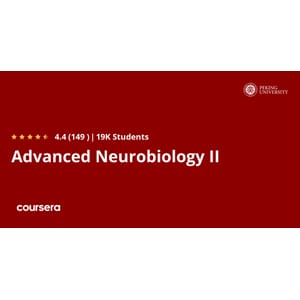Advanced Neurobiology II

About Course
Advanced Neurobiology II: Unraveling the Secrets of the Brain – FREE Course
Dive deep into the fascinating world of neuroscience with this comprehensive course from Peking University. Learn how your brain perceives the world, thinks, responds, and deteriorates during disease or aging. Explore the molecular, cellular, and circuit-level workings of the nervous system.
This advanced neurobiology course covers:
- Basic Neuroanatomy: Understand the structure and organization of the nervous system.
- Electrical Signal Transduction: Learn how neurons communicate with each other.
- Movement and Motor Control: Explore the neural mechanisms underlying movement.
- Neurological Diseases: Gain insights into the causes and treatments of various brain disorders.
This course is part of a two-part series (Advanced Neurobiology I and Advanced Neurobiology II). While related in content, they are independent in terms of scoring and certification. Choose to take either or both. It’s recommended to take them sequentially. Prior knowledge of biology is helpful.
This course is completely FREE and available on platforms like Udemy, Coursera, Udacity, MasterClass, NearPeer, and more!
Keywords: neurobiology, neuroscience, brain, nervous system, neuroanatomy, electrical signal transduction, movement, motor control, neurological diseases, Peking University, free online course, Udemy, Coursera, Udacity, MasterClass, NearPeer
Course Content
Advanced Neurobiology II
-
A Message from the Professor
-
007 01_welcome-to-advanced-neurobiology.mp4
00:00 -
008 02_guide-to-download-the-slides_instructions.html
00:00 -
011 01_1-1-1-ways-to-sense-the-environment-i.mp4
00:00 -
014 02_1-1-2-ways-to-sense-the-environment-ii.mp4
00:00 -
017 03_1-1-3-ways-to-sense-the-environment-iii.mp4
00:00 -
020 04_1-1-4-sensory-transduction-i.mp4
00:00 -
023 05_1-1-5-sensory-transduction-ii.mp4
00:00 -
026 06_1-1-6-sensory-processing.mp4
00:00 -
029 07_1-1-7-sensory-representation-in-the-brain.mp4
00:00 -
032 08_1-1-8-vision.mp4
00:00 -
035 09_1-1-9-single-photon-detection.mp4
00:00 -
038 10_1-1-10-second-messengers.mp4
00:00 -
039 11_quiz-1-1_exam.html
00:00 -
042 01_1-2-1-review.mp4
00:00 -
045 02_1-2-2-phototransduction-i.mp4
00:00 -
048 03_1-2-3-phototransduction-ii.mp4
00:00 -
051 04_1-2-4-phototransduction-iii.mp4
00:00 -
054 05_1-2-5-color-vision-i.mp4
00:00 -
057 06_1-2-6-color-vision-ii.mp4
00:00 -
060 07_1-2-7-signal-processing-of-the-retina.mp4
00:00 -
061 08_quiz-1-2_exam.html
00:00 -
064 01_2-1-1-center-surround-receptive-field.mp4
00:00 -
067 02_2-2-2-the-lgn.mp4
00:00 -
070 03_2-2-3-lgn-and-the-visual-pathway.mp4
00:00 -
073 04_2-2-4-simple-and-complex-cells-i.mp4
00:00 -
076 05_2-2-5-simple-and-complex-cells-ii.mp4
00:00 -
079 06_2-2-6-colors.mp4
00:00 -
080 07_quiz-2-1_exam.html
00:00 -
083 01_2-2-1-sound-transduction-i.mp4
00:00 -
086 02_2-2-2-sound-transduction-ii.mp4
00:00 -
089 03_2-2-3-sound-transduction-iii.mp4
00:00 -
092 04_2-2-4-sound-transduction-iv.mp4
00:00 -
095 05_2-2-5-sound-transduction-v.mp4
00:00 -
098 06_2-2-6-auditory-pathways-and-the-tonotopic-map.mp4
00:00 -
101 07_2-2-7-sound-localization-i.mp4
00:00 -
104 08_2-2-8-sound-localization-ii.mp4
00:00 -
105 09_quiz-2-2_exam.html
00:00 -
108 01_3-1-1-the-senses-of-chemoreception.mp4
00:00 -
111 02_3-1-2-olfactory-organization.mp4
00:00 -
114 03_3-1-3-olfactory-transduction.mp4
00:00 -
117 04_3-1-4-olfactory-adaption.mp4
00:00 -
120 05_3-1-5-identification-of-odorant-receptor-genes-i.mp4
00:00 -
123 06_3-1-6-identification-of-odorant-receptor-genes-ii.mp4
00:00 -
126 07_3-1-7-three-models-of-olfactory-organization.mp4
00:00 -
127 08_quiz-3-1_exam.html
00:00 -
130 01_3-2-1-projection-of-the-olfactory-system.mp4
00:00 -
133 02_3-2-2-circuits-in-the-olfactory-bulb-i.mp4
00:00 -
136 03_3-2-3-circuits-in-the-olfactory-bulb-ii.mp4
00:00 -
139 04_3-2-4-taste-and-taste-receptors-i.mp4
00:00 -
142 05_3-2-5-taste-and-taste-receptors-ii.mp4
00:00 -
145 06_3-2-6-taste-and-taste-receptors-iii.mp4
00:00 -
148 07_3-2-7-taste-and-taste-receptors-iv.mp4
00:00 -
151 08_3-2-8-taste-transduction-i.mp4
00:00 -
154 09_3-2-9-taste-transduction-ii.mp4
00:00 -
155 10_quiz-3-2_exam.html
00:00 -
158 01_4-1-1-parallel-organization-of-the-somatosensory-system-i.mp4
00:00 -
161 02_4-1-2-parallel-organization-of-the-somatosensory-system-ii.mp4
00:00 -
164 03_4-1-3-mechanosensory-neurons.mp4
00:00 -
167 04_4-1-4-response-properties-adaptation-and-stimuli-receptive-field.mp4
00:00 -
170 05_4-1-5-mechanotransduction-channels-i.mp4
00:00 -
173 06_4-1-6-mechanotransduction-channels-ii.mp4
00:00 -
176 07_4-1-7-somatosensory-cortex-somatopic-map-i.mp4
00:00 -
179 08_4-1-8-somatopic-map-ii-barrel-cortex-pain-regulation.mp4
00:00 -
180 09_quiz-4-1_exam.html
00:00 -
183 01_4-2-1-sleep-i.mp4
00:00 -
186 02_4-2-2-sleep-ii.mp4
00:00 -
189 03_4-2-3-sleep-iii.mp4
00:00 -
192 04_4-2-4-sleep-iv.mp4
00:00 -
195 05_4-2-5-circadian-and-sleep-homeostasis.mp4
00:00 -
198 06_4-2-6-sleep-stage-i.mp4
00:00 -
201 07_4-2-7-sleep-stage-ii.mp4
00:00 -
204 08_4-2-8-summary-of-sleep-studies.mp4
00:00 -
207 09_4-2-9-sleep-waking-flip-flop-model.mp4
00:00 -
208 10_quiz-4-2_exam.html
00:00 -
212 01_5-1-1-do-you-take-movement-for-granted.mp4
00:00 -
215 02_5-1-2-brain-imaging-and-functional-areas.mp4
00:00 -
218 03_5-1-3-review-of-the-cns-and-pns-and-cortical-homunculus.mp4
00:00 -
221 04_5-1-4-review-of-the-cerebellum-and-basal-nuclei.mp4
00:00 -
224 05_5-1-5-review-of-the-cranial-nerves.mp4
00:00 -
227 06_5-1-6-review-of-the-cranial-nerves.mp4
00:00 -
230 07_5-1-7-spinal-cord-discomfort.mp4
00:00 -
231 08_quiz-5-1_exam.html
00:00 -
235 01_5-2-1-the-ladder-from-molecules-to-animals.mp4
00:00 -
238 02_5-2-2-biology-and-disease-why-do-we-biologists-care-about-diseases.mp4
00:00 -
241 03_5-2-3-why-do-we-care-so-much-about-the-10-genetic-forms-of-neurological-diseases.mp4
00:00 -
244 04_5-2-4-cellular-functions-what-are-involved-in-neurological-diseases.mp4
00:00 -
247 05_5-2-5-recurring-features-in-neurodegeneration.mp4
00:00 -
250 06_5-2-6-anatomic-deficits-of-ad.mp4
00:00 -
253 07_5-2-7-cell-death-in-ad.mp4
00:00 -
256 08_5-2-8-genes-involved-in-ad.mp4
00:00 -
259 09_5-2-9-practice-whats-the-situation-in-als.mp4
00:00 -
260 10_quiz-5-2_exam.html
00:00 -
264 01_6-1-the-dopamine-system.mp4
00:00 -
267 02_6-2-basal-ganglia-and-its-two-pathways.mp4
00:00 -
270 03_6-3-hd-deficits-in-basal-ganglia.mp4
00:00 -
273 04_6-4-anatomical-deficits-of-hd.mp4
00:00 -
276 05_6-5-cag-repeats-in-hd.mp4
00:00 -
279 06_6-6-are-aggregations-proper-drug-targets.mp4
00:00 -
282 07_6-7-symptoms-of-pd.mp4
00:00 -
285 08_6-8-genes-of-familial-pd.mp4
00:00 -
288 09_6-9-interventions-of-pd.mp4
00:00 -
289 10_quiz-6_exam.html
00:00 -
292 01_7-1-mood-and-emotions.mp4
00:00 -
295 02_7-2-autism.mp4
00:00 -
298 03_7-3-addiction.mp4
00:00 -
301 04_7-4-schizophrenia.mp4
00:00 -
304 05_7-5-depression.mp4
00:00 -
307 06_7-6-bipolar-disorder.mp4
00:00 -
310 07_7-7-causes-of-mood-disorders.mp4
00:00 -
313 08_7-8-treatment-of-depression-and-bipolar-disorder.mp4
00:00 -
316 09_7-9-attention-disorder.mp4
00:00 -
317 10_quiz-7_exam.html
00:00 -
320 01_8-1-introduction-of-behavior.mp4
00:00 -
323 02_8-2-bruce-effect.mp4
00:00 -
326 03_8-3-definition-of-behavior.mp4
00:00 -
329 04_8-4-classification-of-behavior.mp4
00:00 -
332 05_8-5-clock.mp4
00:00 -
335 06_8-6-transcriptional-feed-back.mp4
00:00 -
338 07_8-7-photoentrainment.mp4
00:00 -
341 08_8-8-gene-and-sex-i.mp4
00:00 -
344 09_8-9-gene-and-sex-ii.mp4
00:00 -
347 10_8-10-parabiosis.mp4
00:00 -
350 11_8-11-leptin.mp4
00:00 -
351 12_quiz-8_exam.html
00:00 -
Section Quiz
Earn a certificate
Add this certificate to your resume to demonstrate your skills & increase your chances of getting noticed.

Student Ratings & Reviews


